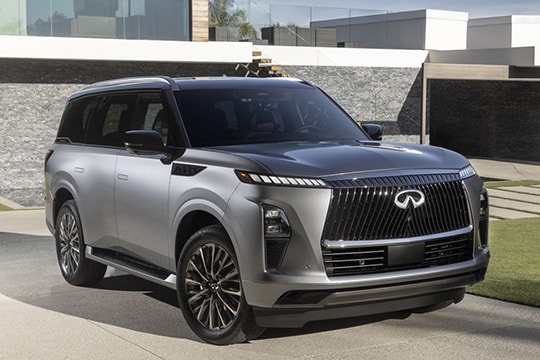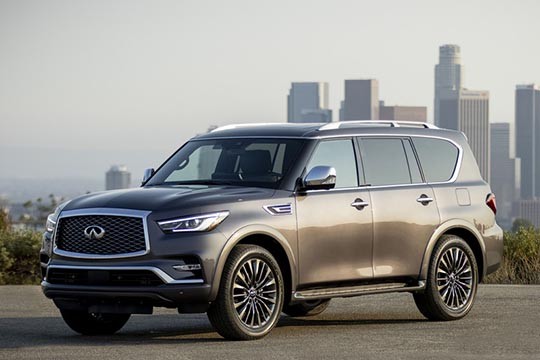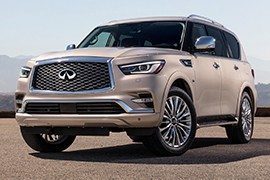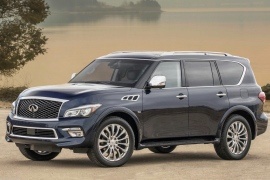INFINITI QX80 Models/Series Timeline, Specifications & Photos
First production year: 2014
Engines: Gasoline
Body style: SUV (Sports Utility Vehicle)
Infiniti unveiled in 2024 a brand new generation of its flagship SUV model, the QX80, trying to get more customers from the other premium brands.
The Japanese premium automaker introduced the first generation of the QX80 in 2004, but it was called the QX56 due to the engine size. In 2010, Infiniti introduced the second sequel of this moniker, and in 2013, the automaker changed the naming strategy for its entire lineup, so the big SUV became the QX80. The luxurious vehicle was based on the same platform as the Nissan Patrol, including the powerplant and the transmission. However, some vehicle features were exclusive to the Infiniti brand and unattainable to Nissan Patrol buyers. Furthermore, the styling of the QX80 was made to impress not just with the size but also with the small details that made the massive SUV stand apart from the crowd.
At the front, the automaker introduced a new design language for the grille, named “Bamboo forest.” It included oblique slats converging towards the center of the vehicle. Flanking it at the upper side, the automaker installed the LED daytime running lights that lit up in a sequence, like it was charging. Lower, on the side scoops, the automaker added the main headlights. Below a chromed horizontal slat, Infiniti installed the radar for the advanced safety systems. There was also a camera that could record the traffic ahead and be downloaded later for review or analysis.
From its profile, the QX80 boasted a tall appearance, with retractable door handles that could open at the owner’s approach, with the key inside their pockets. A set of side steps eased access to the vehicle. There was a choice of seven colors to choose from, and customers could get the SUV with 21- or 22-inch alloy wheels. Infiniti also offered the vehicle two-tone paint, with black roof and pillars, contrasting the lower part of the bodywork. At the back, the automaker installed a broad light element that crossed the vehicle from left to right over the tailgate. There were no visible tailpipes or even fake exhausts, these being concealed under the rear bumper.
Inside, the three-row SUV boasted a high level of luxury. Even the base model featured high-grade materials and a 14-speaker sound system, while a 24-speaker one was on the options list. In front of the driver, Infiniti installed a two-screen system covered by the same piece of glass. Both 14.3-inch displays were neatly integrated into the tall dashboard. A third touchscreen was integrated into the center stack to control the HVAC system. On the middle row, the automaker offered customers the option of two captain seats or a bench seat, while the rearmost row was designed to accommodate three adult-sized occupants. Nissan also provided the option of a panoramic glass roof and a camera that could record or send videos from the vehicle’s interior.
While the 2004 QX56 was available with a naturally aspirated 5.6-liter V8 engine, the 2024 QX80 came with a 3.5-liter twin-turbo V6 powerplant. It was part of the renowned family of the VR35DDTT family and was paired with a nine-speed automatic gearbox that sent power to the rear axle in all corners, depending on the grade and options.
Infiniti refreshed the QX80 lineup in 2021 for the 2022 model year and brought slight exterior improvements and significant interior updates for its largest vehicle in the stable.
The Japanese carmaker decided to bump its entire lineup, and the QX80 flagship received all the credits and improvements to stay on top of its game. Even though it wasn’t the most powerful in its class, it still offered plenty of features to be considered a tough contender.
With a redesigned front fascia that featured the corporate grille with a chromed, surrounding rim, the QX80 provided a commanding view to the road. Its redesigned LED-enhanced headlights and the shining trim that adorned the lower side of the bumper offered the vehicle a premium look, in par with Audi, Mercedes-Benz, or Lexus, but more in the Cadillac and Lincoln styling. But it takes a keen eye to spot the differences between the 2018 and the 2022 model. Still, they exist and can be noticed on the lower grille, which features two slats instead of three.
Inside, the most important upgrade was for the infotainment system. It seems like Infinity used the same Nissan infotainment system since the Nissan Primera P12, with a screen and many buttons arranged at its bottom area. The 2022 QX80 welcomed its customers with a wider and taller 12.3” touch-screen installed on top of the center stack and offered Apple CarPlay and Android Auto connectivity.
Under the hood, Infinity placed the same 5.6-liter V8 engine paired to a seven-speed automatic transmission. It might not be the most fuel-efficient engine in its class, but it is appreciated for its smoothness and reliability.
The second generation of the biggest Infiniti model on the market was the QX80. It was launched in 2010 and it was facelifted twice: in 2013 and 2017.
Unveiled at the 2017 Dubai Motor Show in December, as a 2018 model year, the QX80 was based on the Nissan Armada pickup-truck chassis, which was used for the Nissan Patrol as well. It brought more technology inside, both for safety and for comfort. To ensure the manufacturing quality, the QX80 was produced in Nissan's factory in Yukuhashi, Japan. For the Russian market, the car was assembled from CKD kits in Saint-Petersburg.
The most important visible change of the exterior was on the front side of the car, where the curvy lines were changed with more modern, angular ones. It's new, LED, headlights followed the same design language as for other sedans, SUVs, and coupes from its family. The side air-vents from the front fenders were reshaped accordingly. The taillights were fitted with LED, similar to those found on the QX50 SUV.
The interior was fit for seven or eight passengers, depending on the configuration. An 8” infotainment screen was installed for the front passenger and the driver. For the rear-seat entertainment, the QX80 featured new displays with high-resolution screens, and 3.5mm jack for headphones. The side steps outside the car were enlarged, for easier ingress and egress.
The 2018 model featured adaptive cruise control, lane keep assist, blind-spot warning, and several other safety systems. For the drivetrain, the QX80 featured the same 5.6-liter V8 gasoline engine with rear or four-wheel-drive. The latter enabled all-wheel-drive traction when conditions required it.
Infiniti introduced the second generation of its largest SUV, the QX56, in 2010. The premium Japanese automaker built it on the same platform shared with the Nissan Armada and the Titan, and in 2014, the carmaker updated the model and changed its name to the QX80.
The QX series was Infiniti’s first full-size SUV, and couldn’t afford to fail with it. That’s why the initial model, the 2004 QX56, used the trustworthy platform from the Nissan Patrol. By 2010, it became clear that if that model was large enough for Europeans, it couldn’t match the offers that came from American automakers such as the Lincoln Navigator or Cadillac Escalade. As a result, it took the chassis from its heaviest pickup, the Nissan Titan, and made not just the Armada but also the second QX56. Later, the Japanese marketing department considered it was time for a change in the nomenclature lineup and increased the number behind the letters from 56 to 80. In 2014, the automaker introduced the refreshed version of the second generation of the premium Japanese SUV, the QX80.
While Nissan’s engineers were busy working on all the bits and pieces of the vehicle and were heavily financed by the automaker, the design department looked like it was paid with lunch money. As a result, the big SUV looked strange with the headlights that looked too small for the large front fascia. Moreover, the chromed grille sat higher than those and featured a chromed rim that emphasized its dimensions. The lower side of the bumper, on the other hand, looked fine, with its grille in the middle flanked by the foglamps surrounded by chromed trims. On the vehicle’s profile, the artists placed three-slat vents on the front fenders, but not only were those not needed, but they were fake anyway. Still, the back of the car looked fine with its new, clear-lens, LED taillights.
By 2014, Infiniti already understood that American customers couldn’t accept a premium vehicle as being luxurious if it didn’t have high-quality leather and lacquered wood trims on the dashboard. In addition, the Japanese automaker also used wood for the steering wheel, the center console, and the door cards. Furthermore, even those seated in the rear benefited from this kind of luxurious treatment, sharing a center console with wood grains. The driver got a new design for the instrument cluster filled with large dials and a TFT display. On the upper side of the center stack, Infiniti installed a color screen for the infotainment system, which was controlled by several buttons underneath it. With seating for up to eight people on board, the QX80 was an excellent alternative for luxurious, full-size SUVs that could carry a large family and some friends. When optioned with a second row with captain seats, it became more of a luxury cruiser and less than a people carrier.
Under its skin, the 2015 QX80 retained the original chassis and the 5.6-liter, naturally-aspirated V8 engine. Infiniti paired it as standard with the same seven-speed automatic transmission. The intelligent all-wheel-drive system became a standard feature. Moreover, it also featured a two-speed transfer case for serious off-road situations.



